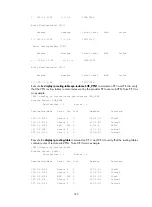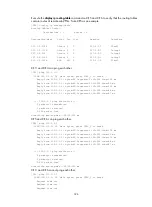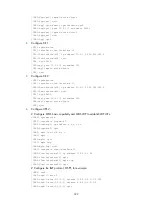
338
Destination/Mask Proto Pre Cost NextHop Interface
3.3.3.3/32 Direct 0 0 127.0.0.1 InLoop0
5.5.5.5/32 BGP 255 0 2.2.2.9 NULL0
20.1.1.0/24 OSPF 10 1563 100.1.1.1 Vlan11
100.1.1.0/24 Direct 0 0 100.1.1.2 Vlan11
100.1.1.2/32 Direct 0 0 127.0.0.1 InLoop0
120.1.1.0/24 BGP 255 0 2.2.2.9 NULL0
Issue the
display ip routing-table
command on the CEs, and you can see that the cost of the OSPF
route to the peer CE is now 10 (the cost configured for the sham link), and that the next hop is now
the VLAN interface 11 connected to the PE. This means that VPN traffic to the peer will be
forwarded over the backbone. Take CE 1 as an example:
[CE1] display ip routing-table
Routing Tables: Public
Destinations : 9 Routes : 9
Destination/Mask Proto Pre Cost NextHop Interface
20.1.1.0/24 Direct 0 0 20.1.1.1 Vlan13
20.1.1.1/32 Direct 0 0 127.0.0.1 InLoop0
20.1.1.2/32 Direct 0 0 20.1.1.2 Vlan13
30.1.1.0/24 OSPF 10 1574 100.1.1.2 Vlan11
100.1.1.0/24 Direct 0 0 100.1.1.1 Vlan11
100.1.1.1/32 Direct 0 0 127.0.0.1 InLoop0
120.1.1.0/24 OSPF 10 12 100.1.1.2 Vlan11
127.0.0.0/8 Direct 0 0 127.0.0.1 InLoop0
127.0.0.1/32 Direct 0 0 127.0.0.1 InLoop0
Issue the
display ospf sham-link
command on the PEs. The output shows that a sham link has been
established. Take PE 1 as an example:
[PE1] display ospf sham-link
OSPF Process 100 with Router ID 100.1.1.2
Sham Link:
Area NeighborId Source-IP Destination-IP State Cost
0.0.0.1 120.1.1.2 3.3.3.3 5.5.5.5 P-2-P 10
Issue the
display ospf sham-link
area
command. The output shows that the peer state is Full:
[PE1] display ospf sham-link area 1
OSPF Process 100 with Router ID 100.1.1.2
Sham-Link: 3.3.3.3 --> 5.5.5.5
Neighbor ID: 120.1.1.2 State: Full
Area: 0.0.0.1
Cost: 10 State: P-2-P Type: Sham
Timers: Hello 10, Dead 40, Retransmit 5, Transmit Delay 1
Configuring BGP AS number substitution
Network requirements
As shown in
, CE 1 and CE 2 belong to VPN 1 and are connected to PE 1 and PE 2 respectively.
In addition, they use the same AS number 600.
















































